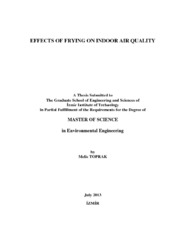Please use this identifier to cite or link to this item:
https://hdl.handle.net/11147/3609Full metadata record
| DC Field | Value | Language |
|---|---|---|
| dc.contributor.advisor | Sofuoğlu, Sait Cemil | - |
| dc.contributor.author | Toprak, Melis | - |
| dc.date.accessioned | 2014-07-22T13:51:56Z | - |
| dc.date.available | 2014-07-22T13:51:56Z | - |
| dc.date.issued | 2013 | - |
| dc.identifier.uri | http://hdl.handle.net/11147/3609 | - |
| dc.description | Thesis (Master)--Izmir Institute of Technology, Environmental Engineering, Izmir, 2013 | en_US |
| dc.description | Includes bibliographical references (leaves: 79-84) | en_US |
| dc.description | Text in English; Abstract: Turkish and English | en_US |
| dc.description | xi, 84 leaves | en_US |
| dc.description | Full text release delayed at author's request until 2015.08.05 | en_US |
| dc.description.abstract | Frying is an important indoor air pollution source. It may cause chronic health effects on cooks. This study measured indoor air concentratinos of volatile organic compounds (VOCs), aldehydes, particulate matter, CO and CO2 in a small scale restaurant kitchen before, during, and after frying with a margarine produced specifically for frying. Both sampling and monitoring strategies were employed. Individual VOCs, aldehydes, and PM2.5 concentrations were determined by sampling. Total VOCs, PM10, CO, and CO2 concentrations were determined using a monitoring device. Temperature and relative humidity were also monitored as comfort variables in addition to CO2. Two campaigns were conducted. In Campaign-1 real working conditions were studied. In Campaign-2 only potatoes were fried with varying amounts. N-heptane, ethyl acetate, nonanal, and n-octane were the realtively higher concentration compounds in both campaigns. The increase in PM10 concentrations, however, was much more pronounced: about five times higher when the lowest concentration observed in the very beginning and the peak concentration during frying are compared, and two times higher when the average concentrations are compared. CO and CO2 concentrations were relatively low, and temperature and relative humidity levels were generally in the comfort zone. The observed PM10 concentrations during frying and the average PM2.5 concentrations (80-250 μg/m3) of 4-hr period that covers the all three periods (before, during, and after) in Campaign-1 indicate that chronic health effects are probable for cooks who frequently cook by frying with the frying margarine. | en_US |
| dc.language.iso | en | en_US |
| dc.publisher | Izmir Institute of Technology | en_US |
| dc.rights | info:eu-repo/semantics/openAccess | en_US |
| dc.subject.lcsh | Indoor air quality--Research | en |
| dc.subject.lcsh | Indoor air pollution--Measurement | en |
| dc.subject.lcsh | Frying | en |
| dc.title | Effects of Frying on Indoor Air Quality | en_US |
| dc.type | Master Thesis | en_US |
| dc.institutionauthor | Toprak, Melis | - |
| dc.department | Thesis (Master)--İzmir Institute of Technology, Environmental Engineering | en_US |
| dc.relation.publicationcategory | Tez | en_US |
| dc.identifier.wosquality | N/A | - |
| dc.identifier.scopusquality | N/A | - |
| item.openairecristype | http://purl.org/coar/resource_type/c_18cf | - |
| item.languageiso639-1 | en | - |
| item.openairetype | Master Thesis | - |
| item.grantfulltext | open | - |
| item.fulltext | With Fulltext | - |
| item.cerifentitytype | Publications | - |
| crisitem.author.dept | 01. Izmir Institute of Technology | - |
| Appears in Collections: | Master Degree / Yüksek Lisans Tezleri Sürdürülebilir Yeşil Kampüs Koleksiyonu / Sustainable Green Campus Collection | |
Files in This Item:
| File | Description | Size | Format | |
|---|---|---|---|---|
| 10011699.pdf | MasterThesis | 1.48 MB | Adobe PDF |  View/Open |
CORE Recommender
Page view(s)
480
checked on Mar 31, 2025
Download(s)
180
checked on Mar 31, 2025
Google ScholarTM
Check
Items in GCRIS Repository are protected by copyright, with all rights reserved, unless otherwise indicated.